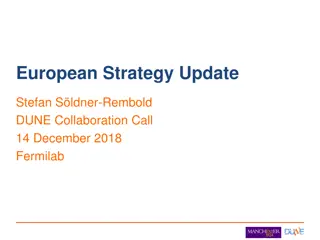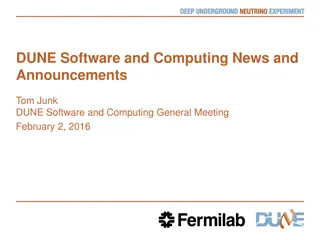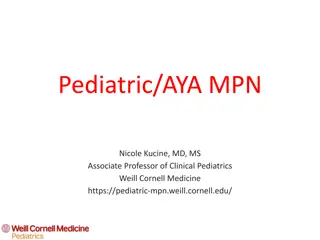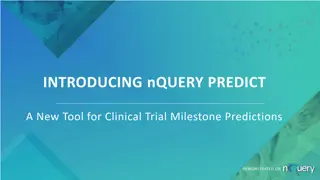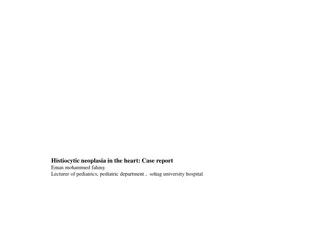Durvalumab Plus Tremelimumab in Advanced Neuroendocrine Neoplasms: The DUNE Trial at ESMO 2020
A multi-cohort phase 2 study presented at ESMO 2020 evaluated the combination of durvalumab and tremelimumab in patients with advanced neuroendocrine neoplasms. The DUNE trial assessed the efficacy of this immunotherapy approach in various neuroendocrine tumor types, emphasizing the potential benefit of targeting both PD-L1 and CTLA-4 pathways to enhance treatment response. The study design, treatment regimen, and primary/secondary endpoints were discussed, highlighting the significance of exploring novel immunotherapeutic strategies in challenging malignancies like neuroendocrine neoplasms.
Download Presentation

Please find below an Image/Link to download the presentation.
The content on the website is provided AS IS for your information and personal use only. It may not be sold, licensed, or shared on other websites without obtaining consent from the author.If you encounter any issues during the download, it is possible that the publisher has removed the file from their server.
You are allowed to download the files provided on this website for personal or commercial use, subject to the condition that they are used lawfully. All files are the property of their respective owners.
The content on the website is provided AS IS for your information and personal use only. It may not be sold, licensed, or shared on other websites without obtaining consent from the author.
E N D
Presentation Transcript
MEETING SUMMARY ESMO 2020, VIRTUAL MEETING Dr. Rachel van Leeuwaarde, MD University Medical Center of Utrecht, Utrecht, The Netherlands HIGHLIGHTS FROM NET CONNECT SEPTEMBER 2020 2
DISCLAIMER AND DISCLOSURES Please note: The views expressed within this presentation are the personal opinions of the author. They do not necessarily represent the views of the author s academic institutions or the rest of the NET CONNECT group. This content is supported by an independent educational grant from Ipsen. Dr. Rachel van Leeuwaarde has no relevant financial relationships to disclose. 3
A MULTI-COHORT PHASE 2 STUDY OF DURVALUMAB PLUS TREMELIMUMAB FOR THE TREATMENT OF PATIENTS WITH ADVANCED NENs OF GEP OR LUNG ORIGIN: THE DUNE TRIAL (GETNE 1601) Capdevila J, et al. ESMO 2020. Abstract #1157O. Oral presentation GEP, gastroenteropancreatic; NENs, neuroendocrine neoplasm 4
BACKGROUND Immune checkpoint blockade (ICB) has shown limited activity in advanced NENs to date, mainly due to the background biology of these neoplasms, with usually low tumour mutational burden, low expression of PD-L1 and low lymphocyte filtration Targeting both PD-L1 and CTLA-4 may increase the efficacy of ICB in NENs and revert the intrinsic resistance: The PD-1 inhibitors, pembrolizumab and spartalizumab, have shown limited activity in well differentiated NETs1,2 The combination of anti-PD-L1 (nivolumab) and anti-CTLA-4 (ipilimumab) has shown promising activity in high-grade NENs3,4 The DUNE study investigated the activity of durvalumab (anti-PD-L1 ) plus tremelimumab (anti-CTLA-4) Patients received durvalumab 1,500 mg and tremelimumab 75 mg, every 4 weeks up to 4 cycles, followed by durvalumab monotherapy up to 9 additional cycles Inclusion EoT Visit Primary endpoint: Cohorts 1-3: 9-month CBR Cohort 4: 9-month OS rate 4 Cycles Screening phase + Baseline 9 Cycles Durvalumab 1,500 mg + Tremelimumab 75 mg Follow-up Durvalumab 1,500 mg Monotherapy Advanced NENs of gastroenteropancreatic or lung origin after progression to standard therapies Secondary endpoints: Safety, PFS, OS, ORR, DOR and biomarker analysis Progression Retreat Multicohort study: C1: Typical/atypical lung carcinoids. Prior therapy with somatostatin analogues and/or targeted therapies or chemotherapy C2: Grade 1/2 gastrointestinal. Prior treatment with somatostatin analogues and targeted therapy such as everolimus or radionucleotides C3: Grade 1/2 pancreatic. Prior treatment with chemotherapy, somatostatin analogues and targeted therapies. 2-4 systemic treatment lines C4: Grade 3 gastroenteropancreatic origin. After first line of chemotherapy with a platinum-based regimen C, cohort; CBR, clinical benefit rate; CTLA-4, cytotoxic T-lymphocyte-associated protein 4; DOR, duration of response; EoT, end of treatment; NEN, neuroendocrine neoplasm; NET, neuroendocrine tumour; ORR, objective response rate; OS, overall survival; PD-1, programmed cell death protein 1; PD-L1, programmed death-ligand 1; PFS, progression-free survival 1. Strosberg J, et al. Clin Cancer Res. 2020;26:2124-30; 2. Yao J, et al. Ann Oncol. 2018;29 suppl 8:viii467-78; 3. Patel S, et al. Clin Cancer Res. 2020:26:2290-6; 4. Klein O, et al. Clin Cancer Res. 2020;26:4454-9. Capdevila J, et al. ESMO 2020. Abstract #1157O. Oral presentation 5
RESULTS irORR, % 123 patients were included (C1=27, C2=31, C3=32,C4=33) All PD-L1 + PD-L1 - Median age 62 years, 59% males, 43% ECOG PS 0 16.6* Cohort 1: Typical/atypical lung carcinoids 7.4 0 Cohort 2: Grade 1/2 gastrointestinal 0 0 0 91% of C4 (grade 3 GEP-NEN) had poorly differentiated tumours Cohort 3: Grade 1/2 pancreatic 6.3 25 0 PRIMARY ENDPOINTS Cohort 4: Grade 3 GEP 9.1 0 7.7 With a median follow-up of 10.8 m: CBR at 9 months (by RECIST v1.1) was: Cohort 1, Typical/atypical lung carcinoids: 7.4% Cohort 2, Grade 1/2 gastrointestinal: 32.3% Cohort 3, Grade 1/2 pancreatic: 25% OS rate at 9 months for cohort 4 was: Cohort 4, Grade 3 GEP: 36.1% (95% CI: 22.9-57) (N=33) * PD-L1 expression only enriched irORR in cohort 1 (p=0.033) SAFETY Cohort 4 Well differentiated N=27 N=31 N=32 100 100% % of alive patients CBR at 9 m <9 m FU No: PD Yes: SD+PR+CR Most common TRAEs: fatigue (43.0%), diarrhoea (31.7%), pruritus (23.6%), nausea (13.8%), hypothyroidism (9.8%) Most frequent grade 3 TRAEs: liver toxicity (9.7%), diarrhoea (6.5%), fatigue (2.4%) and vomiting (2.4%) 75% 75 50% Patients (%) 25% 36.1% 50 0% 0 3 6 9 12 15 18 21 24 27 30 25 Time until death since treatment start date (months) Cohort 4 - 33 21 16 11 10 9 8 8 4 2 1 0 Cohort 1 Cohort 2 Cohort 3 C, cohort; CBR, clinical benefit rate; CI, confidence interval; CR, complete response; ECOG PS, Eastern Cooperative Oncology Group performance status; FU, follow up; GEP-NEN, gastroenteropancreatic neuroendocrine tumours; irORR, immune-related objective response rate; PD, progressive disease; PD-L1, programmed death-ligand 1; RECIST, Response Evaluation Criteria In Solid Tumours; SD, stable disease; TRAE, treatment-related adverse event Capdevila J, et al. ESMO 2020. Abstract #1157O. Oral presentation 6
SUMMARY Durvalumab and tremelimumab combination showed modest activity in this heavily pre-treated population In WHO grade 3 NENs (cohort 4), the combination therapy met the predefined threshold for OS at 9 months and deserves further evaluation Objective radiological responses were infrequent No new safety concerns were identified in this large population of advanced NENs NEN, neuroendocrine neoplasm; OS, overall survival; WHO, world health organisation Capdevila J, et al. ESMO 2020. Abstract #1157O. Oral presentation 7
EFFICACY AND SAFETY OF LANREOTIDE AUTOGEL 120 MG EVERY 14 DAYS IN PROGRESSIVE PANCREATIC OR MIDGUT NETs: CLARINET FORTE STUDY RESULTS Pavel M, et al. ESMO 2020. Abstract #1162MO. Mini oral presentation NETs, neuroendocrine tumours 8
BACKGROUND Currently, patients with progressive disease after treatment with lanreotide (120 mg every 28 days) have limited treatment options and receive less well-tolerated systemic chemotherapy or molecular targeted therapies CLARINET FORTE is a prospective, open label, exploratory, European phase 2 study that investigated the efficacy and safety of an increased dosing frequency of lanreotide in patients with progressive pancreatic neuroendocrine tumours (panNETs) and midgut NETs Patients with metastatic or locally advanced, unresectable panNETs or midgut NETs: SSTR2+ Grade 1 or 2 Ki-67 20% With or without hormonal-related syndromes Centrally assessed progression (RECIST V 1.0) within last 2 years while on standard LAN regimen (120 mg every 28 days) for 24 weeks PanNET cohort (N=48) LAN 120 mg every 14 days for 48 wks Primary endpoint: Centrally assessed PFS (RECIST v 1.0) by independent central review Secondary endpoints: DCR Best overall response Safety Midgut NET cohort (N=51) LAN 120 mg every 14 days for 96 wks DCR, disease control rate; LAN, lanreotide; NET, neuroendocrine tumour; PFS, progression free survival; RECIST, Response Evaluation Criteria In Solid Tumours; SSTR2, somatostatin receptor type 2; wks, weeks https://clinicaltrials.gov/ct2/show/NCT02651987; Pavel M, et al. ESMO 2020. Abstract #1162MO. Mini oral presentation. 9
RESULTS PFS (PRIMARY ENDPOINT) SECONDARY ENDPOINTS PanNET N=48 Midgut NET N=51 1.0 0.9 0.8 0.7 0.6 0.5 0.4 0.3 0.2 PanNET N=48 Midgut NET N=51 Progression-free survival DCR at week 24, % (95% CI) 43.8 58.8 (29.5-58.8) (44.2-72.4) mPFS 5.6 months 95% CI: 5.5-8.3 8.3 months 95% CI: 5.6-11.1 DCR at week 48, % (95% CI) 22.9 33.3 (12.0-37.3) (20.8-47.9) Midgut NET SAFETY 0.0 PanNET Adverse event PanNET N=48 Midgut NET N=51 0.0 0 3 6 9 Time (months) 12 15 18 21 24 TRAEs, % 37.5 51.0 Patients at risk 99 67 51 33 19 14 12 11 0 TRAEs grade 3, n (%) 1 (2.1)* - POST-HOC SUBGROUP ANALYSIS Most common ( 10%) TRAEs, % Gastrointestinal disorders General disorders/administration site conditions 25.0 13.7 37.3 - mPFS by Ki-67 PanNET * Grade 3 TRAE of fatigue Ki-67 10% (n=43) 8.0 months 95% CI: 5.6-8.3 TRAEs of note: hyperglycaemia (n=2), bile stones (n=1), steatorrhea (n=1) Ki-67 >10% (n=5) 2.8 months 95% CI: 2.8-2.9 CI, confidence interval; DCR, disease control rate; mPFS, median progression free survival; NET, neuroendocrine tumour; panNET, pancreatic NET; TRAE, treatment-related adverse event Pavel M, et al. ESMO 2020. Abstract #1162MO. Mini oral presentation 10
SUMMARY Lanreotide (LAN) 120 mg every 14 days in patients with progressive panNETs or midgut NETs (progressive on standard LAN dose) provided encouraging PFS and disease control rate data In the panNET cohort, the outcome was more favourable in patients with Ki-67 10% No new safety concerns were identified with the increased dose frequency of LAN The safety was consistent with the known safety profile of LAN Escalating LAN dosing frequency in patients with progressive NETs may be an alternative treatment option before switching to more toxic agents such as PRRT/targeted therapies/chemotherapy NET, neuroendocrine tumour; panNET, pancreatic NET; PFS, progression free survival; PRRT, peptide receptor radionuclide therapy Pavel M, et al. ESMO 2020. Abstract #1162MO. Mini oral presentation 11
SURVIVAL AND PROGNOSTIC ANALYSIS OF 535 GRADE 3 GEP-NEN: DATA FROM THE SPANISH TASKFORCE OF NEUROENDOCRINE TUMOURS REGISTRY (R-GETNE) Jimenez Fonseca P, et al. ESMO 2020. Abstract #1159MO. Mini oral presentation GEP-NEN, gastroenteropancreatic neuroendocrine neoplasm 12
BACKGROUND Grade 3 neuroendocrine carcinomas (NECs) represent the most aggressive spectrum of neuroendocrine neoplasms (NENS) and have limited treatment options A previous analysis from the GETNE (Spanish) registry confirmed the worse prognosis associated with grade and Ki-67 index in patients with gastroenteropancreatic neuroendocrine tumours (GEP-NETs)1 The R-GETNE database includes 4807 GEP-NENs patients diagnosed between 2004-2019 The study cohort for this analysis included 535 patients with grade 3 NECs with a Ki-67 index >20%2 Results Grade 3 NEC KI-67 >20% N=535 Results 70 years Women ECOG PS 0-1 29% (median age 64) 40% 85% 87% stage I-III NECs were resected 54% of these received adjuvant chemotherapy Most common primary sites Colorectum Pancreas Unknown Stomach Small Intestine 30% 24% 16% 13% 4% 73% of patients with advanced NECs received platin and etoposide Response rate: 64% median progression-free survival (mPFS): 6.1 months Stage at diagnosis I II III IV 3% 9% 20% 68% ECOG PS, Eastern Cooperative Oncology Group performance status; R-GETNE, Registry of Grupo Espa ol de Tumores Neuroendocrinos 1. Nu ez-Valdovinos B, et al. Oncologist. 2018;22:1-11; 2. Jimenez Fonseca P, et al. ESMO 2020. Abstract #1159MO. Mini oral presentation 13
RESULTS Median overall survival (OS) was 14 months; 353 patients died (67%) Median follow up of 4 years Prognostic factors: stage, primary site, ECOG PS and gender were identified as independent prognostic factors for OS (p<0.05) Prognostic Factor HR 95% CI HR Overall Survival Results Min Max Median OS, months 14 Stage Median OS by stage (95% CI), years I II III IV (months) IV I-III Reference 0.43 6.1 (1.8-NA) 5.8 (1.9-NA) 2.1 (1.5-6.7) 9.7 (6.7-12.9) 0.27 0.81 Primary tumour Others Small intestine, pancreas, rectum Reference 0.63 0.44 0.92 Median OS by site in stage IV (95% CI), months Small Intestine Pancreas Rectum Stomach Colon Unknown primary ECOG PS 2 0-1 14.0 (12.6-15.8) 10.1 (9.5-11.8) 9.9 (8.2-11.2) 7.3 (5.2-9.3) 4.7 (2.8-7.0) 2.7 (1.9-3.8) Reference 0.64 0.37 0.77 Gender Male Female Reference 0.89 0.74 0.95 CI, confidence interval; ECOG PS, Eastern Cooperative Oncology Group performance status; HR, hazard ratio Jimenez Fonseca P, et al. ESMO 2020. Abstract #1159MO. Mini oral presentation 14
SUMMARY One of the largest reported series of grade 3 GEP-NECs to date, providing important information to help stratify patients for clinical decisions Performance status, stage and primary tumour location are known prognostic factors for NETs but this is the first cohort study to identify gender as a potential new variable Requires validation in clinical trials GEP-NECs, gastroenteropancreatic neuroendocrine carcinomas; NET, neuroendocrine tumour Jimenez Fonseca P, et al. ESMO 2020. Abstract #1159MO. Mini oral presentation 15
REACH NET CONNECT VIA TWITTER, LINKEDIN, VIMEO & EMAIL OR VISIT THE GROUP S WEBSITE http://www.net-connect.info Follow the NET CONNECT group on LinkedIn Watch us on the Vimeo Channel NET CONNECT Email Follow us on Twitter @net-connectinfo antoine.lacombe @cor2ed.com 16
NET CONNECT Bodenackerstrasse 17 4103 Bottmingen SWITZERLAND Dr. Froukje Sosef MD +31 6 2324 3636 froukje.sosef@cor2ed.com Dr. Antoine Lacombe Pharm D, MBA +41 79 529 42 79 antoine.lacombe@cor2ed.com Heading to the heart of Independent Medical Education Since 2012









